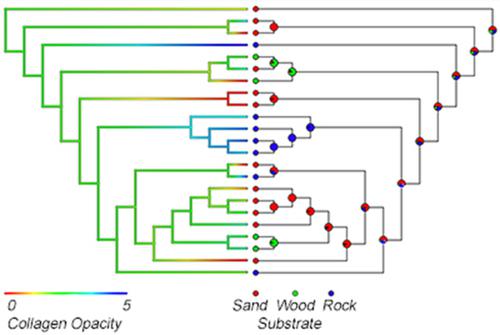当前位置:
X-MOL 学术
›
J. Morphol.
›
论文详情
Our official English website, www.x-mol.net, welcomes your
feedback! (Note: you will need to create a separate account there.)
Evolutionary optimization of an anatomical suction cup: Lip collagen content and its correlation with flow and substrate in Neotropical suckermouth catfishes (Loricarioidei)
Journal of Morphology ( IF 1.5 ) Pub Date : 2020-05-05 , DOI: 10.1002/jmor.21136 Noah R Bressman 1 , Jonathan W Armbruster 2 , Nathan K Lujan 3 , Imoh Udoh 1 , Miriam A Ashley-Ross 1
Journal of Morphology ( IF 1.5 ) Pub Date : 2020-05-05 , DOI: 10.1002/jmor.21136 Noah R Bressman 1 , Jonathan W Armbruster 2 , Nathan K Lujan 3 , Imoh Udoh 1 , Miriam A Ashley-Ross 1
Affiliation

|
In riverine ecosystems, downstream drag caused by fast‐flowing water poses a significant challenge to rheophilic organisms. In neotropical rivers, many members of a diverse radiation of suckermouth catfishes (Loricarioidei) resist drag in part by using modified lips that form an oral suction cup composed of thick flesh. Histological composition and morphology of this cup are interspecifically highly variable. Through an examination of 23 loricarioid species, we determined that the tissue most responsible for lip fleshiness is collagen. We hypothesized that lip collagen content is interspecifically correlated with substrate and flow so that fishes living on rocky substrates in high‐flow environments have the largest, most collagenous lips. By mapping the amount and distribution of lip collagen onto a phylogeny and conducting ANOVA tests, we found support for this hypothesis. Moreover, these traits evolved multiple times in correlation with substrate and flow, suggesting they are an effective means for improving suction‐based attachment. We hypothesize that collagen functions to reinforce oral suction cups, reducing the likelihood of slipping, buckling, and failure under high‐flow, high‐drag conditions. Macroevolutionary patterns among loricarioid catfishes suggest that for maximum performance, biomimetic suction cups should vary in material density according to drag and substrate requirements.
中文翻译:

解剖吸盘的进化优化:唇部胶原蛋白含量及其与新热带鲶鱼(Loricarioidei)的流动和基质的相关性
在河流生态系统中,由快速流动的水引起的下游阻力对流变生物构成了重大挑战。在新热带河流中,吸嘴鲶鱼 (Loricarioidei) 的多种辐射中的许多成员通过使用改良的嘴唇来抵抗拖动,这些嘴唇形成了由厚肉组成的口腔吸盘。该杯的组织学组成和形态在种间高度可变。通过对 23 种loricarioid 物种的检查,我们确定最负责唇部肉质的组织是胶原蛋白。我们假设唇部胶原蛋白含量与基质和流量存在种间相关性,因此在高流量环境中生活在岩石基质上的鱼类拥有最大、最多胶原蛋白的唇部。通过将唇部胶原蛋白的数量和分布映射到系统发育并进行方差分析,我们找到了对这一假设的支持。此外,这些特征与基质和流动相关地多次进化,表明它们是改善基于吸力的附着的有效手段。我们假设胶原蛋白的作用是加强口腔吸盘,减少在高流量、高阻力条件下滑倒、弯曲和失败的可能性。loricarioid 鲶鱼的宏观进化模式表明,为了获得最佳性能,仿生吸盘的材料密度应根据阻力和基材要求而变化。降低在高流量、高阻力条件下滑动、屈曲和失效的可能性。loricarioid 鲶鱼的宏观进化模式表明,为了获得最佳性能,仿生吸盘的材料密度应根据阻力和基材要求而变化。降低在高流量、高阻力条件下滑动、屈曲和失效的可能性。loricarioid 鲶鱼的宏观进化模式表明,为了获得最佳性能,仿生吸盘的材料密度应根据阻力和基材要求而变化。
更新日期:2020-05-05
中文翻译:

解剖吸盘的进化优化:唇部胶原蛋白含量及其与新热带鲶鱼(Loricarioidei)的流动和基质的相关性
在河流生态系统中,由快速流动的水引起的下游阻力对流变生物构成了重大挑战。在新热带河流中,吸嘴鲶鱼 (Loricarioidei) 的多种辐射中的许多成员通过使用改良的嘴唇来抵抗拖动,这些嘴唇形成了由厚肉组成的口腔吸盘。该杯的组织学组成和形态在种间高度可变。通过对 23 种loricarioid 物种的检查,我们确定最负责唇部肉质的组织是胶原蛋白。我们假设唇部胶原蛋白含量与基质和流量存在种间相关性,因此在高流量环境中生活在岩石基质上的鱼类拥有最大、最多胶原蛋白的唇部。通过将唇部胶原蛋白的数量和分布映射到系统发育并进行方差分析,我们找到了对这一假设的支持。此外,这些特征与基质和流动相关地多次进化,表明它们是改善基于吸力的附着的有效手段。我们假设胶原蛋白的作用是加强口腔吸盘,减少在高流量、高阻力条件下滑倒、弯曲和失败的可能性。loricarioid 鲶鱼的宏观进化模式表明,为了获得最佳性能,仿生吸盘的材料密度应根据阻力和基材要求而变化。降低在高流量、高阻力条件下滑动、屈曲和失效的可能性。loricarioid 鲶鱼的宏观进化模式表明,为了获得最佳性能,仿生吸盘的材料密度应根据阻力和基材要求而变化。降低在高流量、高阻力条件下滑动、屈曲和失效的可能性。loricarioid 鲶鱼的宏观进化模式表明,为了获得最佳性能,仿生吸盘的材料密度应根据阻力和基材要求而变化。











































 京公网安备 11010802027423号
京公网安备 11010802027423号